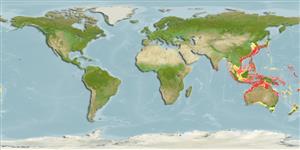Teleostei (teleosts) >
Mulliformes (Goatfishes) >
Mullidae (Goatfishes)
Etymology: Parupeneus: Latin, parum, parvum = small + Peneus, the name of a river.
More on authors: Temminck & Schlegel.
Issue
FishBase common name changed from Yellow striped goatfish to Yellowband goatfish (Uiblein et al., 2024: Ref. 130857).
Environment: milieu / climate zone / depth range / distribution range
Ecology
Marine; demersal; depth range 20 - 200 m (Ref. 54393), usually 74 - 78 m (Ref. 54393). Tropical
Indo-West Pacific: disjunct distribution: Japan to coast of Aomori Prefecture, Honshu, the Izu Peninsula, Kochi Pref., Ogasawara Islands and southeastern Taiwan; in the south from the Arafura Sea, the NW shelf and Kimberly region of Western Australia; from Geographe Bay northwards.
Size / Weight / Age
Maturity: Lm ? range ? - ? cm
Max length : 55.0 cm TL male/unsexed; (Ref. 48636)
Dorsal spines (total): 8; Dorsal soft rays (total): 9; Anal spines: 1; Anal soft rays: 7. This species is distinguished by the following characters: pectoral rays 15-16 (rarely 15); gill rakers 6-7 + 19-22 = 26-28; greatest body depth at or slightly anterior to origin of dorsal fin, 2.9-3.25 in SL; head length (HL) 2.8-3.1 in SL; snout length 1.65-1.9 in HL; cheek depth (lower edge of eye vertically to ventral margin of preopercle) 6.5-9.6 in SL; barbels 1.35-1.45 in HL; the longest dorsal spine 1.5-1.75 in HL; pectoral-fin length 1.25-1.4 in HL, 3.55-4.2 in SL; pelvic-fin length 1.4-1.65 in HL. Colour pale reddish to bluish gray, scale edges red, a yellow stripe from eye to base of caudal fin just above lateral line (stripe may be red in fish from deep water); barbels white to pale yellow (Ref. 54393).
Body shape (shape guide): fusiform / normal.
Apparently occurs in deeper waters in the warmer seas of lower latitudes (Ref. 54393). Inhabits silt or mud bottoms near reefs (Ref. 90102).Done
Life cycle and mating behavior
Maturity | Reproduction | Spawning | Eggs | Fecundity | Larvae
Randall, J.E., 2004. Revision of the goatfish genus Parupeneus (Perciformes: Mullidae), with descriptions of two new species. Indo-Pac. Fish. (36):64 p. (Ref. 54393)
IUCN Red List Status (Ref. 130435: Version 2025-1)
Threat to humans
Harmless
Human uses
Fisheries: bycatch
Tools
Special reports
Download XML
Internet sources
Estimates based on models
Preferred temperature (Ref.
123201): 18.6 - 27.4, mean 25.9 °C (based on 42 cells).
Phylogenetic diversity index (Ref.
82804): PD
50 = 0.5000 [Uniqueness, from 0.5 = low to 2.0 = high].
Bayesian length-weight: a=0.01349 (0.00767 - 0.02371), b=3.08 (2.93 - 3.23), in cm total length, based on LWR estimates for this species & Genus-body shape (Ref.
93245).
Trophic level (Ref.
69278): 3.5 ±0.37 se; based on food items.
Generation time: 3.5 ( na - na) years. Estimated as median ln(3)/K based on 1
growth studies.
Resilience (Ref.
120179): Medium, minimum population doubling time 1.4 - 4.4 years (K=0.31;).
Fishing Vulnerability (Ref.
59153): Moderate vulnerability (36 of 100).
🛈
Nutrients (Ref.
124155): Calcium = 67.9 [27.6, 194.3] mg/100g; Iron = 0.523 [0.251, 1.331] mg/100g; Protein = 17.1 [13.9, 20.1] %; Omega3 = 0.208 [0.106, 0.427] g/100g; Selenium = 120 [51, 318] μg/100g; VitaminA = 39.5 [7.6, 185.5] μg/100g; Zinc = 0.458 [0.261, 0.938] mg/100g (wet weight);
